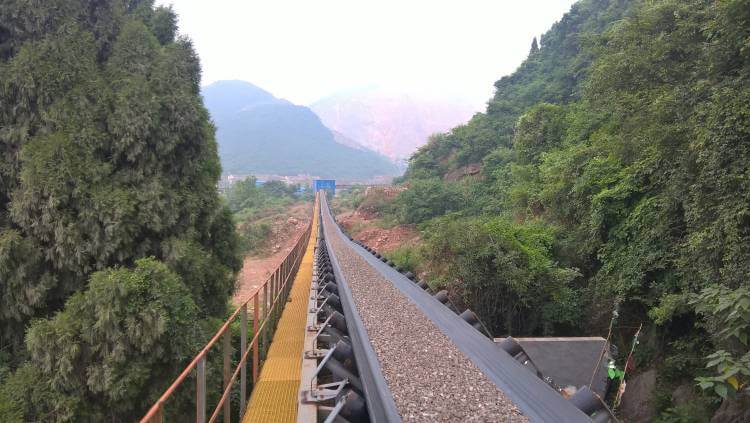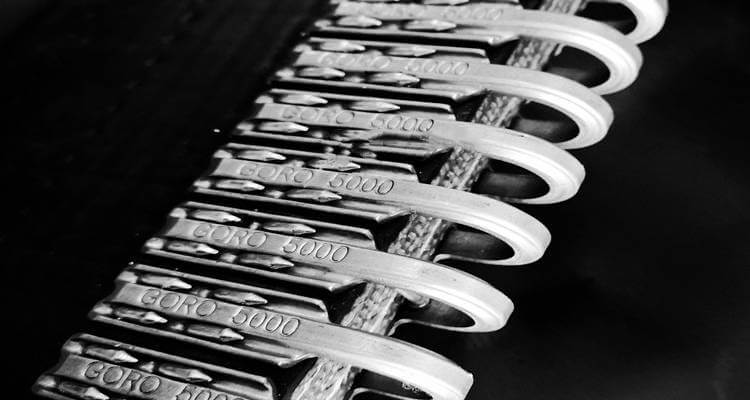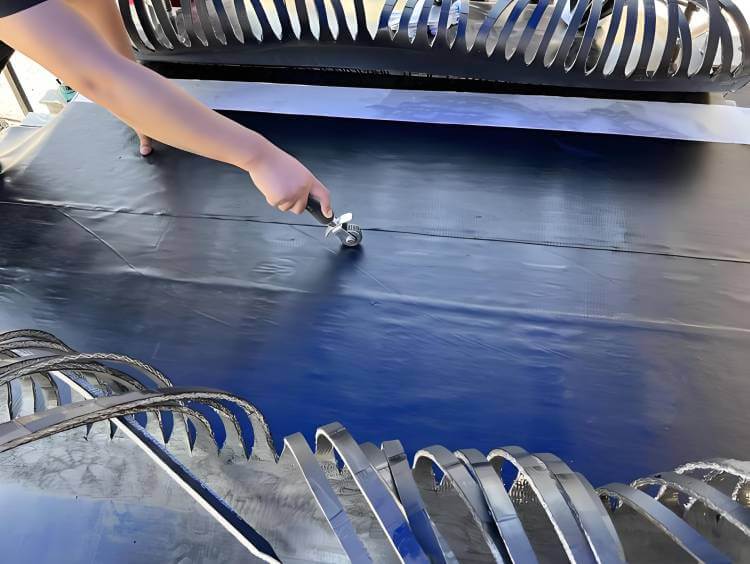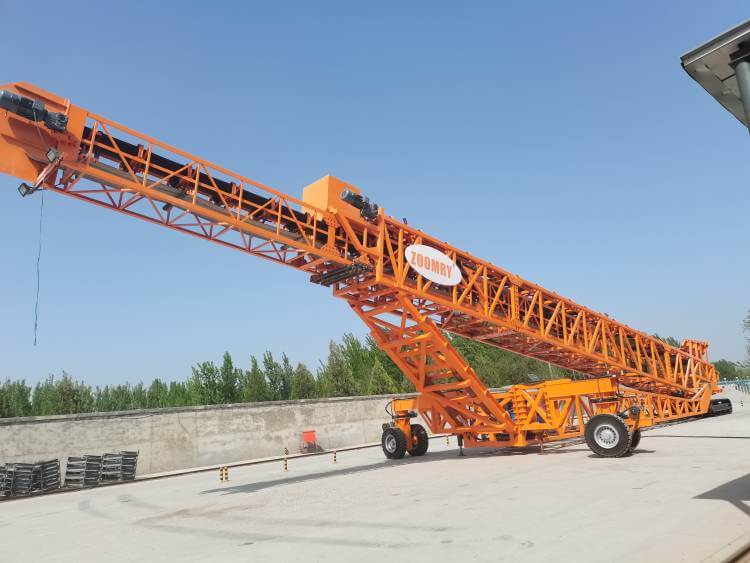According to different requirements based on conveyed materials and application environments, the materials, styles, and connection methods of Conveyor Belts vary. Common conveyor belt materials include PVC conveyor belts, rubber conveyor belts, steel wire rope conveyor belts, fabric core conveyor belts, etc. In the installation and maintenance of conveyor belts, choosing the correct connection method not only ensures the strength of the connection but also improves the equipment’s lifespan and production efficiency.

Common Conveyor Belt Connection Methods
Mechanical Joint Method
The mechanical joint method connects the two ends of the conveyor belt using mechanical connectors. Common connectors include joint clips, bolts, rivets, clamps, etc. This method does not require heating or chemical reactions, and the conveyor belt ends can be fixed directly using mechanical connectors in a short time, making it simple and easy to use. It is suitable for conveyor belt systems that need to bear large loads and require fast repairs or replacements, such as in mining, steel, and fertilizer industries, where heavy material transportation is involved.
Zoomry Heavy Industry, ranked among the top three in the belt conveyor systems industry, provides mechanical joint connection tools, accessories, and methods for some specific scenarios and customer needs, especially high-strength joint and bolt connection systems. These systems use internationally leading technical standards and high-quality raw materials. Whether under extreme temperature and humidity conditions or in high-load and high-speed operations, the belt conveyor systems maintain long-term stability and reliability, reduce equipment failure rates, and improve production efficiency.
Connection Styles
Mechanical joint methods include two types of connections: metallic and non-metallic.
- Metallic connection: Steel joint clips or bars are used to tightly connect the two ends of the conveyor belt. Metallic connections are commonly used for conveyor belts requiring high strength, high speed, or long-term operation. They have extremely high connection strength and can withstand large tensile forces.
- Non-metallic connection: Such as plastic clips and nylon connection pieces, which are generally used for light loads or lighter materials. Compared to metal joints, non-metallic joints are lighter and more economical.
Features of the Mechanical Joint Method
- Easy installation: The mechanical joint method does not require extra steps like heating or cooling. Usually, simple tools such as hammers and wrenches are sufficient to complete the installation. Most mechanical fasteners can be installed in just a few minutes, reducing downtime. Moreover, Zoomry Heavy Industry’s mechanical fasteners are designed with pre-inserted nails or hooks, making the installation process even more convenient.
- Strong adaptability: Mechanical connections are not affected by environmental factors like temperature and humidity and are suitable for various harsh working environments. Whether in high or low-temperature conditions, they maintain good connection performance.
- High load-bearing capacity: Metal joints have strong resistance and a low profile, able to bear significant tension and pressure without damaging the conveyed load or product. Additionally, some mechanical fasteners use non-marking materials, reducing contamination of the conveyed products, making them suitable for high-load environments.
- Easy maintenance: The mechanical connection parts can be easily disassembled when the equipment is damaged or needs to be replaced. As the wear of fasteners is quite noticeable, users can detect and replace damaged parts promptly, reducing unexpected issues during the operation of the conveyor belt. In addition, some mechanical fasteners are designed with removable structures, making maintenance and upkeep more convenient.
- Diverse options: Various types of mechanical fasteners are available on the market to meet the needs of different application scenarios. For example, some fasteners are suitable for light and medium-load applications, while others are designed for heavy-duty and high-strength applications. Users can choose the appropriate fastener based on specific working conditions.
Please contact us using the info below if you have any questions about conveyor belt connection methods
- Zoomry official website
- +86 131-6401-6717
- oversea@zoomry.cn

Hot Vulcanization Joint Method
The hot vulcanization method involves using heat, pressure, and time to bond the two ends of the conveyor belt using vulcanized glue in a dedicated device, making it a solid, seamless whole. Hot vulcanization joints effectively avoid the wear problems associated with mechanical joints, providing a highly stable, smooth, and durable connection. This method is especially suitable for high-load, wide-belt conveyor systems, such as in large mines, coal plants, and steel mills, offering strong connection strength and wear resistance for large bulk material transportation, ore handling, and heavy material transport environments.
Zoomry Heavy Industry’s conveyor belts used in international ports, mines, mobile ship loader, telescopic stacker, truck unloader, and other flexible equipment can opt for hot vulcanization technology, combining advanced equipment and high-performance materials to provide customers with long-lasting connection solutions. The company has an experienced technical team capable of offering personalized hot vulcanization solutions based on different working environments and material characteristics. Through professional hot vulcanization equipment and high-quality vulcanized glue, quick connections are achieved under temperature-controlled equipment, ensuring extremely high reliability and durability. Equipment lifespan is long, and the occurrence of malfunctions in material transportation is less than one in a thousand.
Features of Hot Vulcanization Connection
- Strong connection: The joint formed by hot vulcanization makes the conveyor belt essentially a whole, with high strength and low wear, capable of withstanding large loads and impact forces. It also has high durability. Whether in high or low temperatures, or exposed to chemical corrosion and mechanical wear, the connection remains stable.
- Smooth and seamless: After hot vulcanization, the joint of the conveyor belt is very smooth, with no obvious seams, resulting in low friction, noise, and avoiding material jamming or blockage during transportation. This method also eliminates small particles or bacteria growth points, ensuring hygienic safety during the transportation process and reducing wear on the equipment, thus extending its lifespan.
- Eco-friendly and energy-saving: Hot vulcanization uses advanced heating and pressurizing equipment that precisely controls the quality and performance of the joint. It uses environmentally friendly materials and processes to reduce environmental pollution. At the same time, due to its high strength and durability, it reduces the frequency of conveyor belt replacements, saving resources and energy. This is of significant importance for sustainable development and environmental protection.

Conveyor Belt Connection Method Comparison
Application Scenarios
Mechanical connections are suitable for light and medium-load applications, such as packaging and parts transportation. They are simple to install, cost-effective, and suitable for small and medium-sized enterprises or individual users. Hot vulcanization connections are more appropriate for heavy-duty and high-strength applications, such as in mines, docks, and steel plants. Their smooth, seamless, high-strength characteristics meet the special requirements of these environments.
Maintenance Costs
Mechanical connections are easier to maintain, requiring only regular checks and replacement of worn fasteners. However, as mechanical connectors wear over time, the joints may become unstable, requiring more frequent replacements. On the other hand, hot vulcanization connections are more complicated to maintain and require specialized technicians to operate and maintain. Although the cost of hot vulcanization connections is higher, their durability and stability reduce the frequency of replacements, thereby lowering long-term maintenance costs.
Installation Time
Mechanical connections have a shorter installation time, typically completed within a few minutes. In emergency situations, production can be quickly restored. Hot vulcanization, on the other hand, is a more complex process and takes a longer installation time, often requiring several hours or even longer. Therefore, when choosing the connection method, it is important to consider the impact on downtime and production efficiency.
Environmental Impact
Mechanical connections are highly adaptable to environmental factors and perform well in various harsh environments. However, since the joints involve metal or hard components, they may produce some noise during transportation. Hot vulcanization, however, has certain environmental temperature and humidity requirements and needs to be operated in suitable conditions. Because the conveyor belt is an integral part, no additional noise is generated during material transportation.
When selecting a connection method, users need to balance cost with performance. The mechanical connection method is suitable for users with limited budgets who frequently need to replace connection parts, while the hot vulcanization method is better suited for users requiring high load-bearing capacity and long-term continuous operation.

Choose Zoomry Heavy Industry
As a global leader in bulk material conveyor systems, Zoomry Heavy Industry not only provides belt conveyors, mobile ship loaders, truck unloaders, telescopic stackers, and other conveyor equipment but also offers components such as rollers, drums, conveyor belts, and connection materials and tools. We provide on-site technical support, offering personalized solutions for both mechanical joints and hot vulcanization connections, helping customers quickly and efficiently complete the entire bulk material handling solution.
Other Advantages of Zoomry Heavy Industry Products
- Industry-leading conveyor belts: Zoomry Heavy Industry’s conveyor systems are widely used around the world, with equipment sold to over 70 countries and regions and over 5,000 successful project cases, providing high-quality, high-efficiency conveyor solutions.
- Long product component lifespan: Our equipment meets international usage standards, and the lifespan of components can reach up to 400,000 hours, ensuring long-term efficient operation. The mobile ship loader and telescopic stacker have a telescopic length of up to 65 meters and a capacity of up to 8,400 tons per hour, leading the industry and speeding up bulk material transportation.
- Fast delivery: Mobile ship loaders, telescopic stackers, and other equipment have short delivery cycles, with shipments completed in as little as 20 days. Customers can receive the equipment in a short time and quickly install and use it on-site, without long waiting periods.

 ZOOMRY
ZOOMRY

